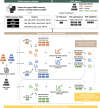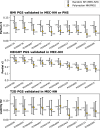The accuracy of polygenic score models for BMI and Type II diabetes in the Native Hawaiian population
- PMID: 40269120
- PMCID: PMC12018950
- DOI: 10.1038/s42003-025-08050-7
The accuracy of polygenic score models for BMI and Type II diabetes in the Native Hawaiian population
Abstract
Polygenic scores (PGS) are promising in stratifying individuals based on the genetic susceptibility to complex diseases or traits. However, the accuracy of PGS models, typically trained in European- or East Asian-ancestry populations, tend to perform poorly in other ethnic minority populations and their accuracies have not been evaluated for Native Hawaiians. In particular, for body mass index (BMI) and type-2 diabetes (T2D), Polynesian-ancestry individuals such as Native Hawaiians or Samoans exhibit varied distribution from other continental populations, but are understudied, particularly in the context of PGS. Using BMI and T2D as examples of metabolic traits of importance to Polynesian populations (along with height as a comparison of a similarly highly polygenic trait), here we examine the prediction accuracies of PGS models in a large Native Hawaiian sample from the Multiethnic Cohort with up to 5300 individuals. We find evidence of lowered prediction accuracies for the PGS models in some cases, particularly for height. We also find that using the Native Hawaiian samples as an optimization cohort during training does not consistently improve PGS performance. Moreover, even the best-performing PGS models among Native Hawaiians have lowered prediction accuracy among the subset of individuals most enriched with Polynesian ancestry. Our findings indicate that factors such as admixture histories, sample size, and diversity in GWAS can influence PGS performance for complex traits among Native Hawaiian samples. This study provides an initial survey of PGS performance among Native Hawaiians and exposes the current gaps and challenges associated with improving polygenic prediction models for underrepresented minority populations.
© 2025. The Author(s).
Conflict of interest statement
Competing interests: C.-Y. C. is an employee of Biogen. Biogen had no role in the research described in this publication. All other authors declare no competing interests.
Figures






Update of
-
The accuracy of polygenic score models for anthropometric traits and Type II Diabetes in the Native Hawaiian Population.medRxiv [Preprint]. 2023 Dec 28:2023.12.25.23300499. doi: 10.1101/2023.12.25.23300499. medRxiv. 2023. Update in: Commun Biol. 2025 Apr 23;8(1):651. doi: 10.1038/s42003-025-08050-7. PMID: 38234828 Free PMC article. Updated. Preprint.
References
-
- Tam, V. et al. Benefits and limitations of genome-wide association studies. Nat. Rev. Genet20, 467–484 (2019). - PubMed
-
- Uffelmann, E. et al. Genome-wide association studies. Nat. Rev. Methods Prim.1, 59 (2021).
MeSH terms
Grants and funding
LinkOut - more resources
Full Text Sources
Medical

